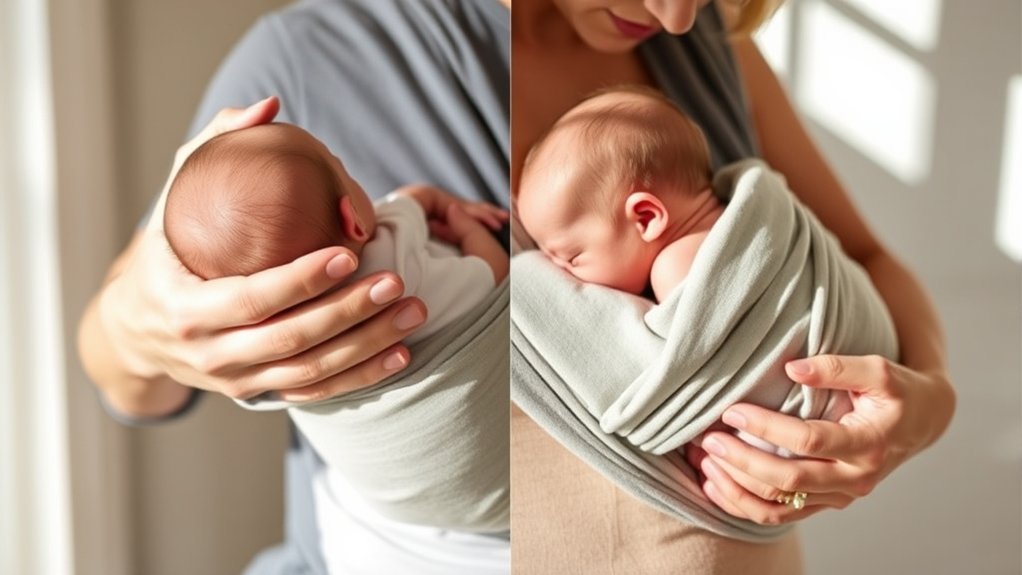Is it true that the way you carry your newborn can greatly impact their development? Many parents in the U.S. choose modern carriers that may not provide the ideal support needed for healthy growth, leading to potential issues like hip dysplasia. Understanding the cultural, resource-related, and educational factors behind these choices can shed light on how to guarantee safer carrying practices. What steps can you take to safeguard your baby’s comfort and health?
Understanding Newborn Carry Positions
When you’re caring for a newborn, understanding carry positions is essential for both your comfort and your baby’s safety. Different carrying styles can greatly impact infant ergonomics, ensuring that your baby’s hips develop properly while reducing strain on your body.
Consider positions like the cradle hold, which promotes bonding, or the upright hold, which allows your baby to explore their surroundings. Always keep your newborn’s spine supported and their legs in a natural position.
You’ll find that experimenting with various styles can enhance your carrying experience, fostering a sense of freedom and connection. Prioritize both your well-being and your baby’s comfort, as this empowers you to navigate the early days of parenthood with confidence and ease.
Cultural Influences on Carrying Practices
Carrying practices vary widely across cultures, reflecting differing beliefs and customs regarding infant care.
You’ll notice that cultural traditions shape how parents choose to carry their newborns, often influenced by community values and familial practices. For example, in some regions, parents might favor slings or wraps that promote closeness and bonding, while others may prefer strollers that allow for ease of mobility.
Regional variations also play a significant role; urban settings may lean towards contemporary methods, whereas rural areas might adhere to traditional techniques.
Understanding these cultural influences not only fosters appreciation for diverse practices but also empowers you to choose what resonates with your values, ultimately enhancing the bonding experience with your infant.
Access to Resources and Its Impact
Although many parents understand the importance of effective carrying techniques for newborns, access to resources greatly shapes their choices. Resource availability often varies by socioeconomic status, influencing which carrying methods are utilized.
Families with limited resources may struggle to acquire proper carriers or attend workshops, impacting their ability to learn and implement safe practices. This lack of access can lead to reliance on less effective methods, putting both parent and child at risk.
Additionally, when parents feel empowered by accessible resources, they can make informed decisions that enhance their carrying techniques. Ensuring equitable access to resources can substantially improve the wellbeing of both parents and newborns, fostering a more liberated approach to parenting that values education and safety.
Educational Gaps in Parenting Techniques
While many parents endeavor to provide the best care for their newborns, educational gaps in parenting techniques often hinder their ability to do so effectively.
Without proper parenting education, you might struggle to understand the various technique variations that can enhance your newborn’s comfort and safety. This knowledge is vital for fostering a nurturing environment.
- You may feel overwhelmed by conflicting advice from friends and family.
- A lack of resources can lead to feelings of isolation and inadequacy.
- Misunderstandings about newborn care can result in stress for both you and your baby.
Safety Considerations for Newborn Carrying
Guaranteeing your newborn’s safety during carrying is essential for both comfort and security. Start by following established safety guidelines, which emphasize proper positioning to prevent strain on your baby’s developing spine.
Always choose carriers that provide ergonomic support, allowing your newborn to maintain a natural, seated posture. This minimizes risks of hip dysplasia and guarantees even weight distribution for you, too.
Be mindful of your surroundings; avoid crowded places where you might bump into obstacles. Regularly check that your baby’s airways are clear and that they’re securely nestled in the carrier.
Finally, trust your instincts—if something feels off, reassess your carrying method. Empower yourself with knowledge, and you’ll create a safe and nurturing environment for your little one.
Frequently Asked Questions
What Are the Benefits of Different Newborn Carry Positions?
Different carry techniques enhance bonding and provide comfort. A benefit analysis reveals that proper positions support your baby’s development, reduce stress, and promote physical closeness, allowing you both to thrive in this nurturing relationship.
How Do Carry Positions Affect Newborn Development?
Carry positions influence attachment styles and physical development by fostering closeness, enhancing sensory experiences, and promoting motor skills. Choosing the right position empowers you to nurture your newborn’s growth, ensuring a strong foundation for their future.
Are There Age Restrictions for Certain Carrying Methods?
Yes, there’re age recommendations for carrying methods. Following safety guidelines is vital to guarantee your newborn’s comfort and development. Always consult pediatric advice to choose the best carrying position as your baby grows.
What Materials Are Safest for Baby Carriers?
When it comes to baby carriers, opting for materials that meet safety standards is essential. Look for breathable fabrics like cotton or linen, ensuring comfort while supporting your little one’s journey through life’s adventures.
How Can I Choose a Carrier That Suits My Lifestyle?
To choose a carrier that suits your lifestyle, evaluate carrier types based on comfort, ease of use, and adjustability. Prioritize lifestyle compatibility, ensuring it meets your daily activities while providing safety and convenience for your baby.
Conclusion
In summary, understanding safe and supportive newborn carry positions is essential for every caregiver. By bridging the educational gaps and boosting access to resources, you can better protect your precious little one from potential risks like hip dysplasia. Cultivating awareness of cultural influences and prioritizing proper techniques guarantees a safer, more comfortable carrying experience. Remember, informed choices lead to healthier habits, fostering a nurturing environment where both you and your newborn can thrive together.
